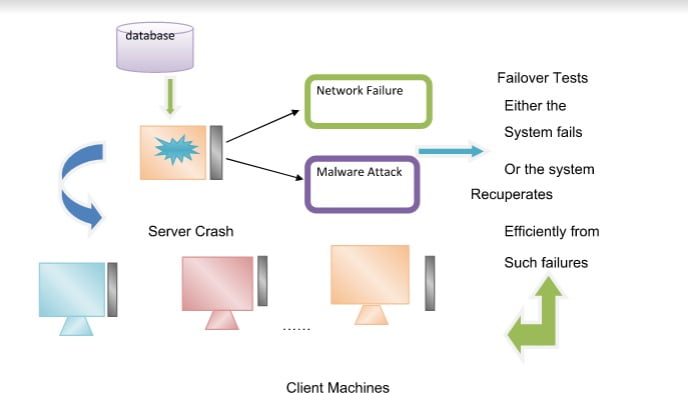Failover testing is a technique to check system’s ability to provide extra resources and the ability to move to back-up systems during the system’s failure due to one or the other reasons.
Examples
- Banking Applications
- Applications related to any business
- Applications related to government.
- Trading applications
The following factors need to be considered for the failover testing:
- Loss for the company during the scheduled down time: It means there will be business loss to the company and the whole operation will be interrupted during the scheduled time.
- The system cost to prevent the system breakdown: It means that when the system reaches the performance threshold where it is bound to break there is need to allocate extra resources to protect system from break down. The cost will be allocated with the extra resources which will also be considered while doing failover testing.
- Duration of downtime: Clients do not prefer to get their operations interrupted for very long period. If the duration is more the client is less likely to approve failover testing.
- Probability of system failover: If the system failure is more likely to happen, then the client is less likely to approve the failover testing.
How to perform the failover testing?
- It should to be planned in terms of performance requirement.
- Setting up a suitable process to meet the performance requirement.
- Prepare test plan as per the market requirement.
- Executing the test plan
- Preparation of report regarding any issue.
While doing the failover testing proper back-up and restore mechanism is necessary. There should be a back up of data so that if any problem occurs during the failover testing the same data can be restored.

Failover testing is basically a integral part of the testing for mission critical systems that are constantly available. The procedure has offloading any tasks to stand by system component so that the procedure is possible for the end user. Failover can be a mechanism to protect against the failed processor in the network. It can be applied to any network component such as a connection path, storage device or web server. The stored data is connected to servers in configurations in very easiest way either point-to-point or cross-coupled in such environment, the failure of a server make data access impossible for large number of users, until server is back to online.
Questions
- What is failover testing?
- Give one example of failover testing?
- What are the advantages of failover testing?




























37 Responses
1. What is failover testing?
Failover testing is a technique to check system’s ability to provide extra resources and the ability to move to back-up systems during the system’s failure due to one or the other reasons.
2. Give one example of failover testing?
Testing associated with the checking the following systems’ ability to provide extra resources and/or utilize back-up systems during system failure:
a. Banking Applications
b. Applications related to any business
c. Applications related to government.
d. Trading applications
3. What are the advantages of failover testing?
Failover testing can protect against the failed processor in the network.
Failover testing can be applied to any network component (e.g. connection path, storage device, web server).
Failover testing can be used for testing mission critical systems that are constantly available.
Failover testing is a Technic to test the system ability to provide extra resources and provide back up system during the crash it can happen with one or other reasons like system crash, Malware attack, etc.
Example like Banking application, Social Networks,ect.
Advantages of this testing easy to back up huge data, fast recovery of data, etc.
Failover testing is a procedure to test system ability to provide extra resources and the ability to move back up system during the system failure due to one or other reasons.
ex:-i have an BANK a/c & wanted to use any function if the 1st server is crashed its not opening then it will perform failover test redirect me to another server without interrupting client.
Advantages:-
Failover testing is basically a integral part of the testing for mission critical systems that are constantly available. The procedure has offloading any tasks to stand by system component so that the procedure is possible for the end user. Failover can be a mechanism to protect against the failed processor in the network. It can be applied to any network component such as a connection path, storage device or web server. The stored data is connected to servers in configurations in very easiest way either point-to-point or cross-coupled in such environment, the failure of a server make data access impossible for large number of users, until server is back to online.
What is failover testing?
Failover testing is a testing technique that validates a system’s ability to be able to allocate extra resource and to move operations to back-up systems during the server failure due to one or the other reasons.
Give one example of failover testing?
A real situation could be we have 3 web servers. Due to heavy load, one fails, so we are left with two web servers. Now the question arises whether the failed server is capable of restarting on its own and will the other two servers be able to handle to load?
What are the advantages of failover testing?
1. Able to identify the phase at which the system stops responding, is a point where the system should be able to take an action. 2. Deliver a robust system to the end user that efficiently serves the purpose it has built or design for.
3. verify that a system is efficiently handling extra resource like additional CPU or servers during a failure.
Failover testing is a technique to check system’s ability to provide extra resources and the ability to move to back-up systems during the system’s failure due to one or the other reasons.
The following factors need to be considered for the fail over testing:
Loss for the company during the scheduled down time: It means there will be business loss to the company and the whole operation will be interrupted during the scheduled time.
The system cost to prevent the system breakdown: It means that when the system reaches the performance threshold where it is bound to break there is need to allocate extra resources to protect system from break down. The cost will be allocated with the extra resources which will also be considered while doing fail over testing. Fail over testing is basically a integral part of the testing for mission critical systems that are constantly available. The procedure has offloading any tasks to stand by system component so that the procedure is possible for the end user. Fail over can be a mechanism to protect against the failed processor in the network. It can be applied to any network component such as a connection path, storage device or web server. The stored data is connected to servers in configurations in very easiest way either point-to-point or cross-coupled in such environment, the failure of a server make data access impossible for large number of users, until server is back to online.
Failover testing is to check the ability of the software for extra resources when the system fails and connects to back up system without interrupting the software application process and losing any data while the failure.
Ex-Bankinkig application.
It helps to not lose any data while the system switches to backup system when the actual system fail to perform.
What is failover testing?
Failover testing is a technique to check the system’s ability to provide extra resources
and the ability to move to back-up systems during the system’s failure due to one
or other reasons.
Give one example of failover testing?
shopping websites during sale time like black Friday some of the websites crash due to a load of users shopping.
What are the advantages of failover testing?
Failover testing keeps proper back-up and restore mechanism is necessary.
There is a back up of data so that if any problem occurs during the failover
testing the same data can be restored.
1.Failover testing:
Failover testing is a technique to check system’s ability to provide extra resources and the ability to move to back-up systems during the system’s failure due to one or the other reasons.
2. example of failover testing:
Online Shopping application
3.Advantages of failover testing:
Failover can be a mechanism to protect against the failed processor in the network. It can be applied to any network component such as a connection path, storage device or web server. The stored data is connected to servers in configurations in very easiest way either point-to-point or cross-coupled in such environment, the failure of a server make data access impossible for large number of users, until server is back to online.
Failover testing is a technique to check the system’s ability to provide extra resources and the ability to move to back-up systems during the system’s failure due to one or the other reasons.
e.g. the online shopping website gives error message during high traffic times like sales and users will be redirected to a different server without interrupting.
Advantages-Helps the recovery data, prevent system crash or failure, prevent facing any losses.
1. What is failover testing?
Failover testing is a technique to check system’s ability to provide extra resources and the ability to move to back-up systems during the system’s failure due to one or the other reasons.
2.Give one example of failover testing?
One example of failover testing: You have four webservers under a heavy load and one of them crashes. Does the load balancer react in the correct manner? Can the other three web servers handle the load? Does the crashed web server restart itself or does it require manual intervention? Is there an automated notification system and did it notify the correct people at the right time?
3.What are the advantages of failover testing?
1. Failover testing is basically a integral part of the testing for mission critical systems that are constantly available.
2. The procedure has offloading any tasks to stand by system component so that the procedure is possible for the end user.
3. Failover can be a mechanism to protect against the failed processor in the network.
1) What is failover testing?
Failover testing is a technique to check system’s ability to provide extra resources and the ability to move to back-up systems during the system’s failure due to one or the other reasons.
2)example of failover testing
in real situation we have 2 web servers in case due to heavy load or once failed.now the failed server is capable on its own and other will be able to handle to load?
3) advantages of failover testing
testing easy to back up huge data, fast recovery of data.
Question: What is failover testing?
Failover testing is a technique to check system’s ability to provide extra resources and the ability to move to back-up systems during the system’s failure due to one or the other reasons.
Give one example of failover testing?
ATM system failover.
What are the advantages of failover testing?
– minimize interruption of transaction
– minimize time loss
– minimize business loss
1 failover testing is extra resources and the ability to move to backup systems during the system failure due to one or the other reasons.
2 example in a Trading company is on maintenance time failover testing make sure it works properly with backup.
3 advantages of failover testing
failover testing makes sure the system works properly in a system failure.
help to recover data after a crash.
A1. Failover testing is a technique to check system’s ability to provide extra resources and backup during a system’s failure.
A2. In banking applications, the system should be available 24/7. So there should be back up available during regular scheduled maintenance of the system. Otherwise, it will affect the customers negatively.
A3. The advantages of failover testing are that the system is constantly available for mission critical systems. Business losses and downtime duration is reduced.
This testing is a technique to check system’s ability to provide extra resources and the ability to move to back-up systems during the system’s failure due to one or the other reasons.Examples:Banking Applications-there should be back up available during regular scheduled maintenance of the system.
Advantage:-minimize interruption of transaction
– minimize time loss
– minimize business loss
1) Failover testing is a technique to check the system’s ability to provide extra resources and the ability to move to back-up systems during the system’s failure due to one or the other reasons. Example: Banking Applications, are working24/7 with the heavy load of data, so in case if the system crashed then the data stored automatically.
3) Advantage of Failover Testing is proper back-up and restore mechanism. There should be a back up of data so that if any problem occurs during the failover testing the same data can be restored.
Fail over testing is a type of testing performed to check if back up systems are available and reliable when primary systems fail or load increases beyond a certain level. For example in banking application when load on primary application server increases the system automatically switch to back up servers to service new request. It helps to certify systems reliability and socialibility.
Failover testing is a technique to check the system’s ability to provide extra resources and the ability to move to back-up systems during the system’s failure due to one or the other reasons.
e.g. the online shopping website gives error message during high traffic times like sales and users will be redirected to a different server without interrupting.
Advantages-Helps the recovery data, prevent system crash or failure, prevent facing any losses.
Failover testing is a technique to check system’s ability to provide extra resources and the ability to move to back-up systems during the system’s failure. For a banking application if the system crashes during a customers transaction process failover testing will prove if there is a back up available for the system when maintenance is being done. This can reduce losses for any business especially consumer services and improve the profitability of the company.
What is failover testing?
Failover testing is a technique to check system’s ability to provide extra resources and the ability to move to back-up systems during the system’s failure due to one or the other reasons.
Give one example of failover testing.
Banking Applications use failover testing so that when the system fails, it would be still able to provide extra resources and would efficiently move to back up systems. by this way the transactions could still occur in a safe and fast manner.
What are the advantages of failover testing?
Failover can be a mechanism to protect against the failed processor in the network. It can be applied to any network component such as a connection path, storage
device or web server. The stored data is connected to servers in configurations in very easiest way either point-to-point or cross-coupled in such environment, the
failure of a server make data access impossible for large number of users, until server is back to online. So having a proper back up will immeadiately fetch the data
avoiding data loss.
Failover testing is a testing technique that validates a system’s ability to be able to allocate extra resource and to move operations to back-up systems during the server failure due to one or the other reasons.
For example:- Telecom Application, Trading Platforms etc
Failover is an important fault tolerance function of mission-critical systems that rely on near-constant availability. Failover automatically and transparently redirects requests from the failed or down system to the backup system that mimics the operations of the primary system.
When the failover process is initiated due to a failure or abnormal termination of an active application, server, system, or hardware component, it is considered an unplanned failover. A failover can also be initiated by administrators to facilitate maintenance of upgrading of the primary system. This is considered a planned failover.
What is failover testing?
Failover testing is a testing technique that validates a system’s ability to be able to allocate extra resource and to move operations to back-up systems during the server failure.
Give one example of failover testing?
– While an application is running, suddenly restart the computer, and then check the the application’s data integrity.
– While an application is receiving data from a network, unplug the connecting cable.
What are the advantages of failover testing?
The advantage is that it gives the ability to provide the end user with a quality software without any loss of data and a seamless user experience.
1. What is failover testing?
Failover testing is a testing technique that validates a system’s ability to be able to allocate extra resource and to move operations to back-up systems during the server failure due to one or the other reasons. This determines if a system is capable of handling extra resource such as additional CPU or servers during critical failures or at the point the system reaches a performance threshold.
2. Give one example of failover testing?
A real situation could be we have 3 web servers. Due to heavy load, one fails, so we are left with two web servers. Now the question arises whether the failed server can restart on its own and will the other two servers be able to handle to load?
3. What are the advantages of failover testing?
Failover testing helps in determining the future requirement of the resource for load balancing
Failover testing is a technique to check system’s ability to provide extra resources and move to back-up systems during the system’s failure for any reason.
Take the example of a banking website: when many users access at the same time if for any reason the application crashes, the load is transferred to backup server. The users may not notice the crash as it won’t affect the operations and there is no system down time.
The advantages of failover testing are to make sure the backup system will be up and running if there is a system failure. This will avoid financial loss, operations of the system are not affected, be prepared in advance in case of system failure.
Failover testing mainly focuses on validating the product’s ability to allocate resources and the operations are moved to the backup systems.
example: Applications related to any business.
Failover can be a mechanism to protect against the failed processor in the network. It can be applied to any network component such as a connection path, storage device or web server.
1.Failover testing is a technique to check system’s ability to provide extra resources and the ability to move to back-up systems during the system’s failure due to one or the other reasons.
2.example: lets consider a banking application and trying to transfer money ,suddenly the system crashes & at the same the system checks to find additional backup resources & redirects to other server or browsers
3.Failover testing is basically a integral part of the testing for mission critical systems that are constantly available. The procedure has offloading any tasks to stand by system component so that the procedure is possible for the end user. Failover can be a mechanism to protect against the failed processor in the network. It can be applied to any network component such as a connection path, storage device or web server. The stored data is connected to servers in configurations in very easiest way either point-to-point or cross-coupled in such environment, the failure of a server make data access impossible for large number of users, until server is back to online.
Failover testing is a technique to check system’s ability to provide extra resources and the ability to move to back-up systems during the system’s failure due to one or the other reasons.Example is online shopping.During sale time the system is crashing
due to more number of users.Failover testing is basically a integral part of the testing for mission critical systems that are constantly available. The stored data is connected to servers in configurations in very easiest way either point-to-point or cross-coupled in such environment, the failure of a server make data access impossible for large number of users, until server is back to online.
1. Failover testing is a technique to check system’s ability to provide extra resources and the ability to move to back-up systems during the system’s failure due to one or the other reasons.
2. An example of failover testing is with a banking application. If the testing goes as it should, the banking application data should not be lost, but rather moved to a back-up system.
3. The advantages of failover testing are to protect against the failed processor in the network and to ensure data is not lost due to a system’s failure. It can be applied to any network component such as a connection path, storage device or web server.
What is Failover testing? Give one example of failover testing. What ate the advantages of failover testing?
Answer: Failover testing is a technique to check weather the system provide extra support to move to back up system during failure due to various reasons.
For example, we have three webservers under load and one of the server crashes. Failover testing verifies that rest of the servers can handle the load.
Advantage of Failover Testing:
It provides back up facilities during crash.
Failover testing is a technique to check system’s ability to provide extra resources and the ability to move to back-up systems during the system’s failure due to one or the other reasons.Examples: Applications related to banking, government, any business. Advantages: Failover can be a mechanism to protect against the failed processor in the network. It can be applied to any network component such as a connection path, storage device or web server.
1)What is failover testing?
Failover testing is a technique to check system’s ability to provide extra resources and the ability to move to back-up systems during the system’s failure
2)Give one example of failover testing?
Failover testing banking applications.
What are the advantages of failover testing?
The advantages of failover testing are to make sure the backup system will be up and running if there is a system failure. This will avoid financial loss, operations of the system are not affected, be prepared in advance in case of system failure.
Failover testing is a technique to check system’s ability to provide extra resources and the ability to move to back-up systems during the system’s failure due to one or the other reasons.
Examples
Banking Applications
Applications related to any business
Applications related to government.
Trading applications
1. What is failover testing?
Failover testing is a technique to check system’s ability to provide extra resources and the ability to move to back-up systems during the system’s failure due to one or the other reasons.
2. Give one example of failover testing?
Banking Applications
The following factors need to be considered for the failover testing:
Loss for the company during the scheduled down time: It means there will be business loss to the company and the whole operation will be interrupted during the scheduled time.
The system cost to prevent the system breakdown: It means that when the system reaches the performance threshold where it is bound to break there is need to allocate extra resources to protect system from break down. The cost will be allocated with the extra resources which will also be considered while doing failover testing.
Duration of downtime: Clients do not prefer to get their operations interrupted for very long period. If the duration is more the client is less likely to approve failover testing.
Probability of system failover: If the system failure is more likely to happen, then the client is less likely to approve the failover testing.
3. What are the advantages of failover testing?
Failover testing is basically a integral part of the testing for mission critical systems that are constantly available. The procedure has offloading any tasks to stand by system component so that the procedure is possible for the end user. Failover can be a mechanism to protect against the failed processor in the network. It can be applied to any network component such as a connection path, storage device or web server. The stored data is connected to servers in configurations in very easiest way either point-to-point or cross-coupled in such environment, the failure of a server make data access impossible for large number of users, until server is back to online.
What is failover testing?
Failover testing is a technique to check system’s ability to provide extra resources and the ability to move to back-up systems during the system’s failure due to one or the other reasons.
Give one example of failover testing?
An example of failover testing is with a banking application. If the testing goes as it should, the banking application data should not be lost, but rather moved to a back-up system
What are the advantages of failover testing?
The advantages of failover testing are to protect against the failed processor in the network and to ensure data is not lost due to a system’s failure. It can be applied to any network component such as a connection path, storage device or web server.
1. What is failover testing?
Failover testing is a technique that validates if a system can allocate extra resources and back up all the information and operations when a system fails abruptly due to some reason. Suppose the PC gets off due to some technical issue, and on restarting we open the browser, then a pop-up is shown saying Do you want to restore all pages? On clicking restore, all tabs are restored. The process of ensuring such restorations is known as failover testing. The factors to consider for failover testing are budget, time, team and technology. The prime purpose is to ensure that it retain the data and resources on time when crashes happen.
2. Give one example of failover testing?
For example, with a failover server, a backup server takes over when the primary server fails. If we have three servers, one of them fails due to heavy load, and then two situations occur. Either that failed server will restart on its own or in another situation when the failed server cannot be restarted, the remaining servers will handle the load. Such situations are tested during this test.
3. What are the advantages of failover testing?
Determines weaknesses, improve user experience, encourages continuous improvement.
Failover testing is a technique to check system’s ability to provide extra resources and the ability to move to back-up systems during the system’s failure due to one or the other reasons.
eg.Applications related to government.
– the failure of a server make data access impossible for large number of users, until server is back to online.
–While doing the failover testing proper back-up and restore mechanism is necessary. There should be a back up of data so that if any problem occurs during the failover testing the same data can be restored.
Failover testing:
Failover testing is a technique to check a system’s ability to provide extra resources and the ability to move to back up systems during the system failure.
Example: Applications related to any business.
Advantage:
Failover testing can be a mechanism to protect against the failed processor in the network.
It also verifies the system’s ability to continue day-to-day operations.
The processing part is transferred to a backup and the system can allocate additional resources when needed.